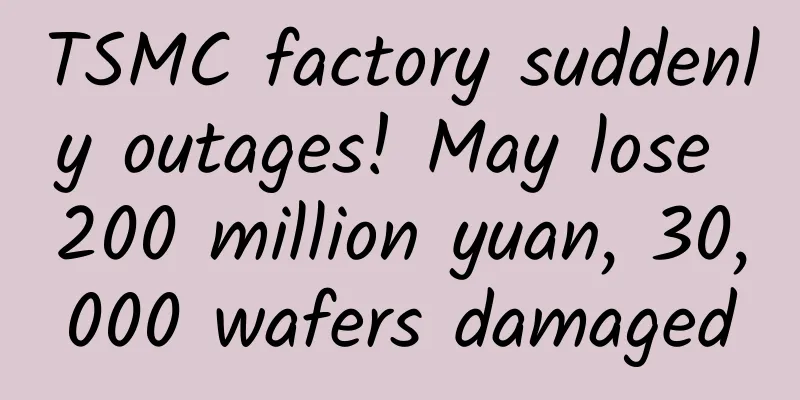TSMC factory suddenly outages! May lose 200 million yuan, 30,000 wafers damaged

|
According to Taiwanese media reports, yesterday morning, TSMC's Fab14 P7 plant in Nansho suddenly lost power. The industry estimated that 30,000 wafers were affected and the loss amount was within NT$1 billion (equivalent to RMB 230 million). The factory mainly produces automotive electronic chips. This accident is undoubtedly adding insult to injury for the chip shortage problem that needs to be solved urgently in the near future. TSMC responded that the power outage was caused by an abnormality in the cables at the Nanke ultra-high voltage substation. Currently, all personnel in the factory are safe and sound. Power has been restored by diesel generators, and the company is working with Taipower to restore normal power supply. 1. Sudden power outage affected 30,000 wafers, with losses reaching NT$1 billionAccording to Taiwanese media reports, at around 11:06 a.m., Sanfu Gas, which is adjacent to the Nan Ke plant, was carrying out a new plant construction project. During the vertical well ground riveting operation in the plant, it accidentally damaged the 161kV underground cable of the power supplier Taipower, causing the Nan Ke-Sanfu line to trip, thus triggering a power outage. The Fab14 P7 plant in Nanke mainly produces 12-inch wafers and is one of TSMC's important bases for 40nm and 45nm process production. ▲TSMC Fab14 P7 plant (Source: Google Maps) Southern Taiwan Science Park practitioners pointed out that TSMC's Fab14 plant was affected by today's power outage, and approximately 30,000 wafers will be affected, with the estimated loss amount being within NT$1 billion. As for whether all of them will be scrapped, we need to wait for TSMC to make further assessment. The number of scrapped wafers depends on the process conditions at the time. Some of them should be salvageable. In addition, TSMC has insurance, so the actual loss should be further reduced. But this is probably not good news for customers, because the Fab14 P7 plant mainly produces automotive electronic chips, and the continued shortage of such chips has seriously affected production in the automotive industry. In response, TSMC issued a statement: "TSMC's wafer plant 14 P7 was out of power today due to an abnormal cable in the Nanke ultra-high voltage substation. There are no safety concerns for colleagues in the plant and no personnel were evacuated. The power has been restored by diesel generators and we are working with Taipower to restore normal power supply. The actual impact will be clarified after normal power supply is restored." UMC's 12-inch fab in Nankai was also affected and had to reduce production, but UMC said the fab responded immediately and did not affect production operations. In addition, Innolux, HannStar, Corning, and Chip Microelectronics all had production reduction issues. After emergency repairs, the power supply to the park has now returned to normal, but the exact amount of losses remains to be determined. 2. Failure of electrical equipment has caused fires, and the pressure of electricity consumption has been difficult to resolveIn fact, this is not the first time that TSMC has had abnormal power equipment problems. On the morning of March 31 this year, TSMC's Fab12 P6 plant caught fire due to overload and heating of the substation equipment. According to Taiwanese media reports, TSMC's outsourced personnel were performing maintenance on the factory's power substation equipment when white smoke suddenly came out of the equipment and the fire-fighting equipment was immediately activated to extinguish the fire with carbon dioxide. During the fire-fighting process, one construction worker was choked by carbon dioxide. Apart from that, there were no other casualties, and there was not much impact on TSMC's production line operations. Going back further, on August 15, 2017, due to human error, a major blackout occurred in Taiwan, China, which had a wide impact. Some media reported that at that time, the Taiwanese government supplied all the remaining electricity to chip manufacturers such as TSMC to reduce their losses. TSMC’s power problem has actually always existed. TSMC founder Morris Chang has emphasized the power problem several times. He once said that the impact of power outages on TSMC is "almost incalculable." Chip manufacturing is a huge resource-intensive industry. According to Greenpeace, TSMC alone accounts for nearly 5% of Taiwan's total electricity consumption. TSMC's corporate social responsibility report shows that in 2019, TSMC's global electricity consumption reached about 14.33 billion kWh, an increase of 5.412 billion kWh from five years ago. In 2019, Taiwan's green energy generation was 14 billion kWh, which was only enough to cover TSMC's consumption. When TSMC's 3nm chip factory is launched, the power consumption of the 3nm factory alone is expected to reach 7 billion kWh. According to data from Bloomberg Industry Research, due to the large-scale use of EUV lithography equipment in 5nm and 3nm, TSMC's demand for electricity will double within three years. It is expected that by the end of 2023, when TSMC's 5nm and 3nm factories are running at full speed, the demand for new circuits will almost reach 98% of TSMC's global electricity consumption in 2019. Under such great pressure on electricity consumption, TSMC has taken action many times, such as contracting wind farms, teaming up with equipment suppliers to develop "green machines", and even proposed a plan to build its own power plant, but it was not approved. 3. Droughts, earthquakes and other "natural disasters" continue, but have not yet caused significant impactsIn addition to power problems, natural disasters such as drought and earthquakes in Taiwan have also affected TSMC. According to media reports, TSMC's annual water consumption is between 16 billion and 17 billion tons. Its 8-inch wafer production line consumes 250 cubic meters of water per hour, and its 12-inch wafer production line consumes up to 500 cubic meters per hour. Since October last year, Taiwan's water supply situation has been quite severe. Currently, due to climate reasons, seven of Taiwan's 21 major reservoirs have less than half of their water storage capacity, and the dry season may continue until May this year. To this end, companies in Hsinchu, Miaoli and Taichung need to reduce water consumption by 7% to 11%. In order to prevent the drought from affecting production, TSMC has begun to supply water to some of its factory facilities through water trucks. On Tuesday, Xinhua News Agency reported that the head of Taiwan's disaster response center said that he hoped to use water continuously until the arrival of the plum rains through measures such as "supply five days a week and stop two days a week". The spokesperson also stated that production in Taiwan's science parks and industrial parks has not been affected. In addition to facing water shortage problems, TSMC also suffered two consecutive earthquakes within two months. On December 11, 2020, a 6.7-magnitude earthquake occurred in the waters of Yilan, Taiwan, China, and the entire island of Taiwan felt the tremor. On January 11 this year, Taiwan was hit by another 5.9-magnitude earthquake. In these two earthquakes, the intensity of the earthquake in TSMC's northern plant reached 4 degrees, and some personnel were evacuated. TSMC said that the two earthquakes "did not cause significant impact" on the company's operations. Conclusion: Chip production has been hit hard, and costs may continue to riseThe power outage at TSMC is likely to have a certain impact on chip production. Considering that chip factories of Samsung, NXP, Infineon and other companies in Austin, Texas, also stopped due to snowstorms, the chip supply situation this year is not optimistic. Under such circumstances, the already tight chip supply problem may further escalate. If downstream application demand remains high, the impact of a series of natural and man-made disasters on chip factories may aggravate the imbalance between chip supply and demand, causing chip costs to continue to rise. |
>>: 6G brings an innovative revolution, but also hides many crises and challenges
Recommend
Professor of the University of Tokyo: Insufficient 5G development affects Japan's 6G strategy
After ignoring electric cars in the field of new ...
RAKsmart: Hong Kong/Japan/Korea/US hot-selling servers starting from $46/month, 1-10Gbps bandwidth servers available
A few days ago, we shared the news that RAKsmart&...
In the 5G era, how can telecom operators lead the future through IoT services?
Major global telecom operators have been explorin...
DigitalOcean: AMD EPYC+NVMe series are all online, and 8 computer rooms support hourly billing
The tribe has not shared information about Digita...
2021 Information and Communication Industry Events
ICT industry recovers According to statistics fro...
How to quickly build an enterprise full-scenario database management platform in one stop?
Gartner's report shows that by 2022, 75% of d...
Can Chrome DevTools' Network be used like this?
If you were to pick the most used feature in Chro...
Impact of 5G Networks on Fiber Cabling Requirements
By Kara Mullaley, Corning Inc. [[394802]] 5G netw...
The emerging industries brought by 5G have exploded, creating so many new jobs, so there is no need to worry about unemployment
I have had my driver's license for more than ...
[Black Friday] HawkHost virtual hosts up to 30% off, reseller hosts up to 50% off, cloud servers up to 30% off
HawkHost's Black Friday promotion starts at 1...
Aruba Launches First-Ever Asset Tracking Solution to Improve Workforce Efficiency and Customer Experience at a Low Cost
The solution uses new Bluetooth Low Energy (BLE) ...
Sharktech upgrades bare metal, Los Angeles/Denver/Chicago/Netherlands high-defense servers starting at $79/month, 1~10Gbps unlimited traffic
Sharktech upgraded its website and products this ...
Ultra-wideband is no longer a highlight: 10 thoughts on 6G by Wu Hequan, an academician of the Chinese Academy of Engineering
At the Global 6G Technology Conference held recen...
Deutsche Telekom warns: Banning Huawei will hinder Europe's 5G development
Europe will fall behind the United States and Chi...
Industry 4.0 is driving enterprise fiber access
Industry 4.0 has brought with it a wave of value-...









